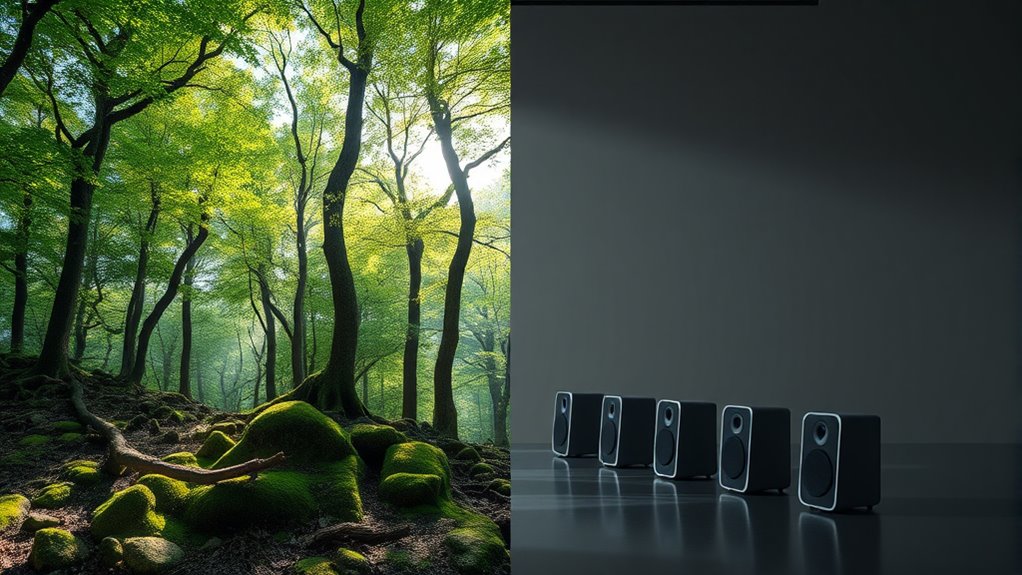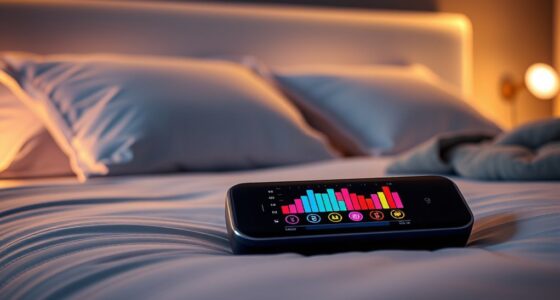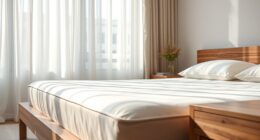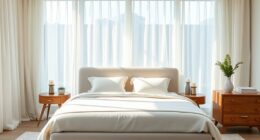When choosing between nature and synthetic sounds in sleep sound libraries, consider what helps you relax best. Nature sounds like rain or ocean waves offer authentic ambient details that can activate calming responses. Synthetic sounds like white or pink noise provide consistent, unobtrusive background support, especially useful in noisy environments. Both types can be effective when high-quality recordings are used. To discover which suits your preferences and needs better, you’ll want to explore more options.
Key Takeaways
- High-quality nature sounds offer authenticity and subtle ambient details that enhance relaxation and immersion, aiding sleep.
- Synthetic sounds provide consistent, customizable background noise ideal for blocking external disruptions.
- Both sound types can promote relaxation effectively when chosen based on personal preferences and sensitivities.
- Nature sounds activate physiological calming responses, while synthetic sounds excel in noisy environments.
- Sound quality is crucial; clear, distortion-free recordings increase effectiveness in sleep sound libraries.
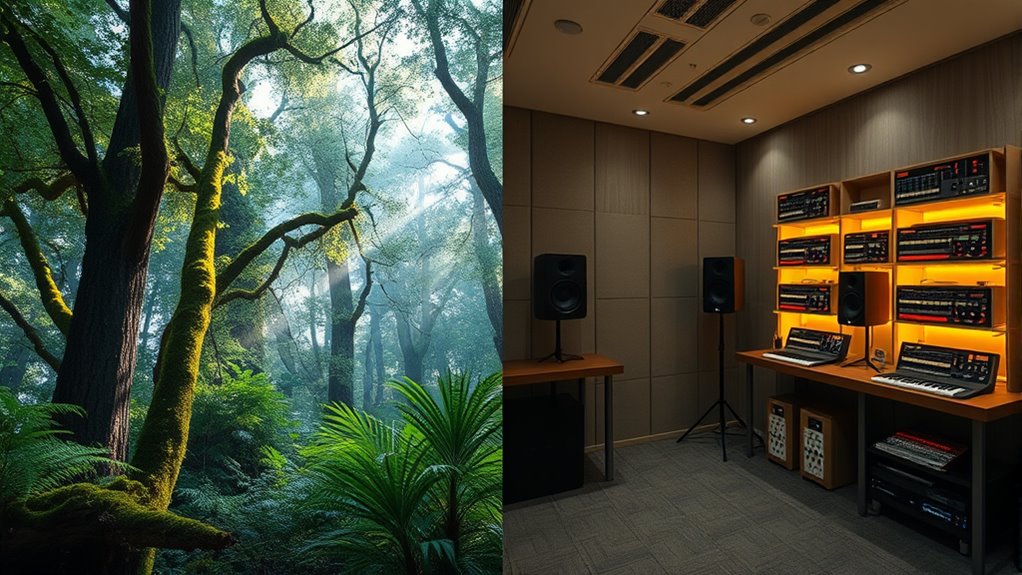
Have you ever struggled to fall asleep and wondered if certain sounds could help? You’re not alone. Many people turn to sleep sound libraries to find that perfect background noise, but the debate between nature sounds and synthetic options often comes up. When exploring these choices, consider how music therapy plays a role and how sound quality influences your overall experience. Both types of sounds can promote relaxation, but understanding their differences helps you make the best choice for your sleep routine.
Nature sounds, like gentle rain, ocean waves, or rustling leaves, are often praised for their natural calming effects. These sounds are typically recorded in high sound quality, capturing the subtle nuances and ambient details that make them feel authentic. This authenticity can enhance your sense of immersion, making it easier to drift into sleep. Many find that listening to nature sounds mimics the calming environment of being outdoors, which can activate the parasympathetic nervous system—the part that promotes rest and digestion. Music therapy also taps into these natural soundscapes, using them deliberately to induce relaxation. When these sounds are of high sound quality, they preserve the richness and depth, avoiding the tinny or muffled effects that can occur with lower-quality recordings. This clarity helps your brain focus on the soothing elements without distractions, creating a more effective sleep cue.
High-quality nature sounds enhance immersion and relaxation, making it easier to drift into sleep.
Synthetic sounds, on the other hand, include white noise, pink noise, or artificially generated ambient tones. They are often designed to be consistent and unchanging, blocking out disruptive environmental noises. Because synthetic sounds are produced electronically, they can be precisely engineered for sound quality, minimizing distortions or abrupt shifts that might disturb your sleep. Many sleep sound libraries offer these options because they can be easily customized in volume, tone, and pattern. They work well in environments where external noise is unpredictable, providing a steady, unobtrusive background. Music therapy also incorporates synthetic sounds, especially in clinical settings, to help individuals relax or manage anxiety. When synthetic sounds are of high sound quality, they serve as a reliable sleep aid, creating a stable auditory environment that promotes calmness without overwhelming your senses.
Ultimately, whether you prefer nature sounds or synthetic options depends on your personal preferences and sensitivities. Both can be highly effective when chosen thoughtfully, especially if you prioritize good sound quality. The key is to find sounds that resonate with you, enhance your relaxation, and create a peaceful atmosphere conducive to sleep. By understanding the differences and benefits of each type, you can build a sleep sound library tailored to your needs, making your nightly routine more restful and restorative.
Frequently Asked Questions
Which Type of Sleep Sound Library Is More Effective for Children?
You might wonder which sleep sound library is better for children. It’s important to contemplate the effects on sleep, as natural sounds often promote relaxation and consistency, helping kids fall asleep faster. Caregiver preferences also matter, since many prefer nature sounds for their calming effects. Ultimately, trying both types can help you discover what works best for your child’s sleep routine, ensuring a more restful night for everyone.
Can Synthetic Sounds Cause Dependency or Reduce Natural Sleep Quality?
You might worry synthetic sounds cause dependency or sleep disruption, but research shows they’re unlikely to foster sound dependency or harm natural sleep. While some fear overuse, moderate use typically supports relaxation without reducing sleep quality. It’s important to monitor your child’s response, but synthetic sounds can be a helpful, non-intrusive aid for better sleep, especially when natural sounds aren’t available. Just ensure they’re used thoughtfully, not as a sole sleep crutch.
How Do Sound Libraries Impact Individuals With Sensory Processing Disorders?
You might find that sound libraries impact individuals with sensory processing disorders by either easing or heightening sensory overload and sound sensitivity. If the sounds are calming and predictable, they can help reduce anxiety and improve focus. However, if the sounds are too loud or unpredictable, they may increase discomfort. Carefully selecting or customizing sounds helps you create a soothing environment that minimizes sensory overload and supports your needs.
Are There Any Health Risks Associated With Prolonged Exposure to Synthetic Sounds?
You might think synthetic sounds are harmless, but long-term effects like auditory fatigue can sneak up on you. Prolonged exposure may dull your hearing or cause stress, ironically making your sleep worse. While they seem safe, synthetic sounds could pose health risks over time, affecting sleep quality and overall well-being. So, be mindful—what seems like a harmless backdrop might actually wear down your ears and mind.
How Do Ambient Noise Levels Influence the Choice Between Natural and Synthetic Sounds?
Ambient noise levels greatly influence your choice between natural and synthetic sounds. In noisy environments, sound masking helps reduce disruption, so you might prefer synthetic sounds that effectively mask background noise. Conversely, in quieter settings, natural sounds create a more calming atmosphere. Your goal should be to select sounds that balance ambient noise, providing a soothing background that promotes restful sleep without overwhelming your senses.
Conclusion
Ultimately, whether you choose the gentle whispers of nature or the calming hum of synthetic sounds, your perfect sleep companion is out there. Think of it as finding a cozy corner in a busy café—something that feels just right. Trust your instincts and let your preferences guide you. With a little patience, you’ll discover the soundscape that softly lulls you into peaceful slumber, making each night a gentle retreat from the day.
